Tech trends 2013
What is in this article?
Increased mobile device use indicated
Once again the survey showed to what extent the respondents' workforces used mobile devices as the primary means of performing their jobs. This year, the results showed that 58.5 percent as compared to last year's 56.5 percent of respondents had less than 45 percent of their workforce as primarily mobile, and 41 percent as compared to last year's 43 percent responded that between 45 percent up to 100 percent of their workforce conducts their jobs primarily using mobile devices. The latest survey suggests that overall less city and county workers are becoming mobile, however that result may be skewed with so many new responders over last year's survey. Recent PTI surveys show a steady increase in mobile device use across all areas of local government.
With the mobile force growing over the years, we wanted to learn more about the use of telework in local governments. The federal government has promoted the concept and requires all federal agencies to develop policies and offer guidance. Despite the discussions about how telework might work in local and state governments, 70.8 percent as compared to last year's 73 percent of the respondents say their agency did not allow telework, compared to 29.2 versus 27 percent that say they did. Even though the follow-up question noted that more employees have smart phones and access to broadband, about the same percentage of respondents did not predict a change in the policy.
PTI continues to hear that many public managers have expressed concern about implementing a formal telework program. The reasons offered focus primarily on inadequate polices, lack of consistent or robust broadband service, fear that telework employees may not be properly monitored, and the difficulty in determining who might be the best candidates for telework. Most say that, given the obstacles, they would rather simply stay out of this area as opposed to picking and choosing. The same group we spoke with indicated that in the next few years, they might evolve toward a telework strategy.
PTI also has noticed a new trend where localities are no longer supplying mobile devices (mostly smart phones) and requiring employees to use their own with city or county support through a partial reimbursement. As a result of the policy change, workers say they prefer carrying one device, rather than the agency's device plus their own personal unit. Nevertheless, 76.3 percent of localities surveyed say they still are supplying devices to selected workers.
Only 10.2 percent say they are requiring their employees to purchase their own devices, and 5.4 percent say they may do so to select workers in the near future; both numbers are ahead of last year's responders. Many stated they are working on what is now referred to as bring-your-own-device or BYOD policies.
How apps are evolving
The term "consumerization of technology" has been used to describe some rather powerful mobile devices that are nothing short of hand-held computers with amazing functionality. The growth of smart phones in the general public continues to increase by more than 30 percent a year.
With rapid growth in mind and to better connect with residents, many localities are building or using mobile applications or simply "apps." For those respondents to our survey who offer mobile apps, 61.3 percent (as compared to last year's 53 percent) say they are being used for reporting infrastructure problems, followed by 48.6 percent – up from last year's 43.1 percent – to access city hall. Other categories of apps include traffic updates, zoning and land use, transit schedules and routes, and economic development.
When asked whether the government was planning on using mobile apps in the future, 55.7 percent say "Yes" or "Maybe," compared with last year's 40 percent and 26.1 percent who said "No." This year's survey shows growth in those planning to offer apps with more reporting "No" and quite a few less who expressed uncertainty. PTI believes that mobile apps will continue to prosper as more third-party apps become available and best practice emerges illustrating their usefulness and importance to residents.
The consumerization of technology will affect local governments one way or another as workforces adopt more sophisticated devices, which can be said for the general public, as well. When asked if this trend would likely lead to either greater IT decentralization or greater IT centralization, about 48 percent of the respondents thought things would stay about the same, with the rest of responders being split between the decentralization versus centralization. The effects of the consumerization of technology on the centralization trend also will be interesting to follow, as more technology-savvy employees will be entering the local government workforce.
Generally, when justifying an IT cost, the survey found the expense referred to as an investment rather than an expense. The survey asked whether IT spending was ultimately considered either an investment, spending to achieve greater efficiencies, or a necessary expense.
Because respondents could check all responses that applied, about 65 percent say that IT is ultimately considered either a necessary expense or to achieve greater efficiencies, with about 44 percent saying they viewed IT spending as an investment aimed at saving money in the longer term. There was little significant difference between sampling years.
With several interesting key findings, including that IT spending is not declining for the majority of respondents, Tech Trends 2013 has helped establish a new baseline for continued study.
Certainly between the continuing adoption of Cloud computing along with the growth of smarter mobile devices, it will be interesting to follow the development of IT governance at the local and state levels of government.
Alan Shark is executive director and CEO of Public Technology Institute and associate professor of practice at Rutgers University School of Public Affairs and Administration.
















